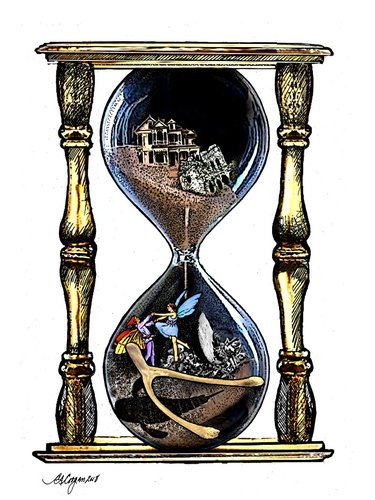Historic preservation allows us all to leave a rich legacy.
Sometimes dreams come true. Sometimes visions are realized.
Fifteen years ago, we bemoaned the loss of a magical site in New Scotland and called on the town to preserve its history. “It’s unrealistic to think that government or private donors could buy development rights for all the important views in town,” we wrote in this space. “But, if the sites are identified and listed, some property owners may donate such rights.”
Now the New Scotland Historical Association, led by President Alan Kowlowitz, is undertaking just such an initiative. The association is being guided by the work that was done in Clifton Park.
“If they could get something done to preserve historic structures and historic sites in a town that was exploding with growth, then we should be able to replicate that in New Scotland, or in Voorheesville,” Kowlowitz told our New Scotland reporter, Sean Mulkerrin.
Both of those municipalities have recently adopted comprehensive plans so the time is ripe to come up with a list that could delineate the buildings and sites residents consider important. Owners could then be encouraged, through tax incentives, to preserve them.
A survey conducted for New Scotland’s plan showed that close to 75 percent of residents responding said that conserving New Scotland’s historic buildings was “important,” “very important,” or “extremely important.”
Clifton Park has its own historic register — with plaques on buildings that qualify — for being associated with an important event or person, for embodying the style of an era or having high artistic value, or for producing historical information.
We printed with Mulkerrin’s story last week pictures of two important sights that can no longer be seen in New Scotland. One was the Voorheesville train station, emblematic of the railroads that built the village.
In the neighboring village of Altamont, a citizens’ group saved the depot when the passenger trains no longer ran and the station was no longer needed. It now serves as a new kind of center for the community — a library.
But, if a building isn’t saved, it can’t be adapted to new uses. Voorheesville residents realize the importance of the station as a replica of the long-gone depot was built as a pavilion — with the same distinctive witch’s hat for a roof — at the head of the rail trail that goes to Albany.
New Scotland Town Board members recently worked with the Mohawk Hudson Land Conservancy to save the gigantic century-old Hilton Barn, which a developer had planned to tear down for a new housing subdivision. The barn was moved across Route 85A from its original site, and now centers a parkland as houses sprout up around it.
Because the Hilton Barn has been saved, a real piece of rural history remains a visible icon that will be adapted to new use.
The New Scotland site that was destroyed 15 years ago wasn’t man made; it spoke of prehistoric history and was a draw for geologists near and far. Quirky cartoonish dips in a field on the Altamont-Voorheesville Road, at the foot of the Helderberg escarpment, seemed like a magical place. For hundreds of years, farmers had worked around this ancient oddity. Kids imagined the depressions were a giant’s footprints or a fairyland.
A decade-and-a-half ago, houses were built in the field, but, because of the ice-age topography, the place still maintained its charm. The north polar ice cap had expanded during the Pleistocene Epoch until it reached as far south as Long Island; when the ice sheets began to melt, huge blocks of ice became buried in sediment, insulated from the sun’s heat, leaving depressions when the ice melted that geologists called glacial kettles.
In 2003, the kettles were filled with construction rubble, causing many residents to express anger or regret. There was nothing illegal about a landowner filling in a depression so why then were people upset? Because sometimes ownership isn’t just a matter of who holds a mortgage with the bank, or whose name is on a property deed. A community can feel a sense of ownership for an historic site or a natural wonder in its midst.
If the historical association proceeds with its work and the town board backs its plan, property owners may take civic pride in such natural wonders and preserve them.
We like the approach the association is taking, which would provide tax incentives to encourage property owners to preserve a natural site or a building and have it identified as historic. Property owners would be able to voluntarily opt into a preservation law, which is far more palatable than having requirements handed down.
“I think people are generally positive about historic preservation,” Kowlowitz said, “but as soon as you start putting restrictions on property owners, it becomes perceived as being bureaucratic.”
We agree with Kowlowitz, too, that a town historic preservation commission should be made up of a range of people, including contractors or developers. Clifton Park’s Historic Preservation Commission has 15 members, appointed by the town board, including at least one: architect, historian, licensed real-estate broker, attorney, and resident of a historic district.
Preserving history in a thoughtful way not only improves lives for residents who, like those in New Scotland, value it, but such an initiative makes the place attractive for visitors, spawning growth for a myriad of businesses — from restaurants to shops — that can sustain a rural economy.
We’ll conclude with our words from 15 years ago: “We suggest the committee survey New Scotland’s residents and come up with a list of sites the community considers important. What features, what places are unique to New Scotland? Any place can have big new homes built on leveled land. What makes New Scotland special? …. We must preserve the magic left to us before it has all disappeared before our very eyes.”


